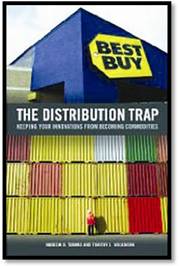University Communications and Marketing
Business professor's new book: Don't Fall into the 'Distribution Trap'
March 22, 2015
Contacts:
Dr. Tim Wilkinson, College of Business, 657-2134
Dan Carter, University Relations, 657-2269
Dr. Tim Wilkinson and colleague say innovators should think clearly about their options
MSU BILLINGS NEWS SERVICES — The stores are huge. The signs are bright and colorful. Customers come in droves.

With all that going for mega-retailers like Wal-Mart, Home Depot and Best Buy, there is an obvious attraction for innovative and entrepreneurial manufacturers to form a partnership to sell their goods, right?
Sure, as long as that manufacturer wants to relinquish total control of manufacturing, marketing, distribution and — possibly — their entire future to that mega-retailer.
That’s the central message of a new book co-authored by a Montana State University Billings business professor that has been recently published.
“The Distribution Trap: Keeping Your Innovations from Becoming Commodities” was written
by Dr. Tim Wilkinson, associate professor of marketing in the College of Business,
with co-author and colleague Dr. Andrew Thomas. Thomas is an assistant professor of
international business at the University of Akron. The pair have collaborated on scholarly
research and have had their work on this topic published in The Wall Street Journal
in 2007.
For Wilkinson, who has been at MSU Billings for about five years, the book is not
one of those tomes to take a whack at Wal-Mart. It’s more of a business management
cautionary tale, a book filled with case studies that illustrate what happens when
innovators see mega-retailers as a quick path to fame and fortune.
“We try not to blame them (mega-retailers like Wal-Mart),” Wilkinson said in a recent interview. “They have a business model that works just great for them. It’s a power relationship with manufacturers.”
And it’s a relationship that attracts plenty of suitors, he said. Scores of well-intended but starry-eyed innovators make the trek to Bentonville, Ark., (Wal-Mart’s home base) to try to partner with the company and get their product in front of millions of customers. When they choose route, they travel down a dangerous road.
“The Distribution Trap” maintains that by entering into a partnership with a mega-retailer, innovative leaders are wrongly convinced that the future of their company is best left in the hands of others who really don’t have the blood, sweat, tears, time and money invested in their product. The mega-retailers depend on volume, mass marketing and low prices and in order to maintain their end of those power relationships, the small manufacturer has no choice but to ratchet everything up.
“They are put into a box where they have to constantly produce and keep feeding the machine,” Wilkinson said. “So they go big into debt. It’s a very dangerous situation.”
The book notes that having innovations turned into commodities with razor-thin profit margins is a dangerous place for companies to reside.
“This is particularly damaging for companies with innovative products,” the authors write. “In the hands of a Mega, shelves are packed with competing products from multiple manufacturers. An innovative product loses its luster when it is surrounded by a slew of potential substitutes, many of which are cheap knockoffs. … Compounding the problem, store clerks receive little or no training on the specifics of the products on display. Employees may know only where a product is located, not what makes it stand out. From this standpoint, the outcomes for the innovator are not surprising: the abandonment of brand integrity, the acceleration of the innovation into a commodity, and the inevitable cots cuts that results from offshoring and outsourcing.”
The key, said Wilkinson, is being vigilant on controlling distribution and costs to increase profits.
The book offers plenty of examples on bad business decisions as well as good decisions that keep innovative businesses competitive.
There’s the story about Levi’s jeans, which was an American success story until it ventured into mass marketing and distribution. And then there’s the story about Jones Soda, which in the early part of the 21st century was a trendy line of soft drinks sweetened only with cane sugar. It had successfully segmented its market share through distribution in tattoo parlors, snowboarding shops and other trendy places.
Company leaders then decided in 2005 to abandon its strategy of direct contact with young customers for big deals with Target and eventually Wal-Mart. By 2007, it had gone from a $39 million profit a year earlier to an $11.6 million loss.
 “The Distribution Trap” authors point to success story as well, however. One is STIHL,
which markets its chainsaws, blowers, brushcutters and trimmers to independent hardware
stores. By controlling its own distribution and marketing plan, it has controlled
its own destiny, the authors say.
“The Distribution Trap” authors point to success story as well, however. One is STIHL,
which markets its chainsaws, blowers, brushcutters and trimmers to independent hardware
stores. By controlling its own distribution and marketing plan, it has controlled
its own destiny, the authors say.
“We discovered STIHL to be a vindication of everything we’ve been saying,” he said.
Wilkinson said he and Thomas wrote the book over the past year and he is using some of the lessons he learned in the process in his marketing classes. And he said, while the book is written by academics, it has a different tone.
“We’re kind of preaching this concept,” he said. “It’s not the usual academic approach. The main message is: Don’t do it.”
The book is published by Praeger.
TOP PHOTO ABOVE: Dr. Tim Wilkinson, an associate professor of marketing in the MSU Billings College of Business, co-wrote “The Distribution Trap with colleague Dr. Andrew Thomas, an international business professor at the University of Akron. Wilkinson’s research focuses on how government policies can be used as a basis of strategic advantage in international business competition.
